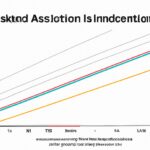The Atkinson index measures income inequality by gauging the distribution of wealth in a society. It takes into account how much individuals’ utility is affected by income disparities. A higher Atkinson index indicates higher inequality, as it suggests that a society’s wealth is concentrated in the hands of a few. The index is named after economist Anthony Atkinson, who developed it in the 1970s. It is commonly used in economic research and policy analysis to understand the impact of income inequality on social welfare. By quantifying the level of inequality, policymakers can make more informed decisions to address societal disparities and promote a fairer distribution of wealth.
Table of Contents
- Calculation method of Atkinson index
- Definition of Atkinson index
- Interpretation of Atkinson index
- Limitations of Atkinson index
- Practical applications of Atkinson index
(Gini Coefficient and Lorenz Curve)
The Atkinson index is a measure used in economics to gauge income inequality within a society. It was developed by economist Anthony Atkinson and has since become a widely used tool for policymakers. The index provides a single number that represents the extent of inequality, with higher values indicating higher levels of inequality.
To interpret the Atkinson index, it’s crucial to understand its range. The index ranges from 0 to 1, with 0 representing perfect equality and 1 indicating extreme inequality. A higher Atkinson index indicates a greater concentration of income among the wealthy.
For instance, if a country has an Atkinson index of 0.3, it implies that if the top earners were to contribute 30% of their income to the poorest individuals, the overall inequality would be reduced. This measure helps identify the level of redistribution required to achieve a more equitable distribution of income.
It is important to note that the Atkinson index does not capture the entire spectrum of income inequality. Although it provides a valuable snapshot, it does not consider factors such as wealth distribution, education, or social mobility, which are vital aspects of economic inequality.
Despite its limitations, the Atkinson index remains a useful tool for economists and policymakers to measure and monitor income inequality over time. By understanding the interpretation of the index, stakeholders can develop targeted policies and interventions to address inequality and promote more inclusive economic growth.
Calculation method of Atkinson index
The Atkinson index is an important measure used to assess income inequality within a society. One of the key aspects of understanding this index is knowing the calculation method used to derive it.
The calculation of the Atkinson index involves three main steps. First, the absolute deviation from the mean income is calculated for each individual in the society. This deviation represents how far each person’s income is from the average income of the entire population.
Next, these absolute deviations are raised to a power, which is known as the Atkinson parameter. This parameter, denoted by epsilon, determines the level of aversion to inequality. A higher value of epsilon indicates a greater aversion to inequality.
After the deviations are raised to the power of epsilon, they are summed up for all individuals in the society. This sum represents the total inequality in the distribution of income.
Finally, the Atkinson index is derived by dividing the sum of the absolute deviations raised to the power of epsilon by the mean income, and then subtracting this value from 1. The resulting index ranges between 0 and 1, where 0 represents perfect equality and 1 represents maximum inequality.
To better understand this calculation method, let’s consider an example. Suppose we have a society with five individuals and their respective incomes are $10,000, $20,000, $30,000, $40,000, and $50,000. The mean income would be the sum of these incomes divided by 5, which is $30,000.
We then calculate the absolute deviations from the mean income for each individual: $20,000, $10,000, $0, $10,000, and $20,000. Let’s assume we use an Atkinson parameter of 0.5.
Raising each absolute deviation to the power of 0.5, we get $141.42, $100, $0, $100, and $141.42. Summing up these values gives us $482.84, which represents the total inequality in this society.
Dividing this sum by the mean income of $30,000, we get approximately 0.016. Subtracting this value from 1, we find that the Atkinson index for this society is approximately 0.984, indicating a high level of inequality.
In conclusion, the calculation method of the Atkinson index involves calculating the absolute deviations from the mean income for each individual, raising them to a specified power, summing them up, and then dividing this sum by the mean income. The resulting index provides a measure of income inequality in a society.
Definition of Atkinson index
The Atkinson index is a measure used to assess income inequality within a given population. It provides a numerical value ranging from zero to one, with higher values indicating greater levels of inequality. Developed by British economist Anthony B. Atkinson, this index takes into account the distribution of income among individuals and the preferences of society towards inequality.
The Atkinson index is an important tool for policymakers and analysts to evaluate the impact of economic policies on income inequality. It allows them to compare different countries or regions and identify areas where income disparities are more pronounced. By understanding the extent of inequality, policymakers can develop targeted interventions to address the underlying causes and promote more equitable growth.
To calculate the Atkinson index, one must first determine the society’s “inequality aversion parameter,” which represents society’s fairness preferences. This parameter quantifies how much society values income equality versus income differences. A higher value indicates a greater preference for equality.
Next, the Atkinson index incorporates information about income distribution. It considers both the average income in society and the proportion of income that goes to different groups. The index adjusts for varying income levels by applying a parameter known as the “inequality epsilon.” This parameter specifies the level at which income differences become significant enough to reflect inequality.
The formula for the Atkinson index involves raising each individual’s income to the power of the inequality epsilon, summing these values, and finally taking the reciprocal of the result. This resulting value represents the level of inequality in society.
The interpretation of the Atkinson index is straightforward. A value of zero signifies perfect income equality, indicating everyone has the same income. On the other hand, a value of one indicates maximum inequality, where all income is concentrated in the hands of a few individuals.
While the Atkinson index provides a useful snapshot of income inequality, it is important to consider other factors that influence socioeconomic disparities. Sustainable development, quality education, access to healthcare, and social mobility are just a few aspects that contribute to a more comprehensive understanding of inequality. Nonetheless, the Atkinson index remains a valuable tool for policymakers seeking to promote fairer and more inclusive societies.
Interpretation of Atkinson index
The Atkinson index is a commonly used measure of income inequality that provides insight into the distribution of income within a society. It was developed by economist Anthony Atkinson and is calculated using a Gini coefficient approach.
The interpretation of the Atkinson index is relatively straightforward. It ranges from 0 to 1, with 0 indicating perfect equality and 1 indicating extreme inequality. The closer the index is to 0, the more evenly income is distributed among the population.
For example, if a country has an Atkinson index of 0.2, it suggests that the top 20% of the population controls 80% of the total income. On the other hand, an Atkinson index of 0.6 would indicate that the top 60% of the population controls only 40% of the total income.
The Atkinson index also allows policymakers and researchers to compare income inequality across different countries or regions. It provides a standardized measure that can be used to track changes over time and inform the design of policies aimed at reducing inequality.
In addition to the overall index, the Atkinson index can be broken down into different percentiles to provide a more nuanced understanding of income distribution. This allows for the identification of specific groups within a population that may be particularly disadvantaged or advantaged in terms of income.
It is important to note that the interpretation of the Atkinson index should be done in conjunction with other measures of income inequality and poverty, as it only focuses on income distribution and does not account for other factors such as wealth or access to essential services.
Overall, the interpretation of the Atkinson index provides valuable insights into the distribution of income within a society and can inform policy decisions aimed at reducing inequality. By understanding how income is distributed, policymakers can work towards creating a more equitable society where everyone has access to the resources and opportunities they need to thrive.
Limitations of Atkinson index
The Atkinson index is a commonly used measure in economics to assess income inequality within a population. However, like any statistical tool, it has its limitations that must be considered when interpreting the results.
One limitation of the Atkinson index is that it focuses solely on income distribution and does not take into account other dimensions of inequality, such as wealth inequality or access to education and healthcare. This narrow focus can provide an incomplete picture of overall inequality within a society.
Furthermore, the Atkinson index assumes that all individuals have the same preferences and values when it comes to income distribution. In reality, people may have different ideas about what constitutes a fair distribution of income. This means that the Atkinson index may not capture the full complexity of inequality as experienced by different groups within a population.
Another limitation of the Atkinson index is that it does not consider the effects of government policies and interventions on income distribution. For example, redistributive policies such as progressive taxation or social welfare programs can significantly impact income inequality. However, these effects are not captured by the Atkinson index alone.
Additionally, the Atkinson index does not account for differences in the cost of living across regions or countries. It assumes that a dollar has the same value for everyone, regardless of their location or purchasing power. This can lead to a skewed representation of inequality, especially in highly unequal societies.
Finally, the Atkinson index is a relative measure of inequality and does not provide information about the absolute level of poverty or well-being within a population. It focuses on the gap between the rich and the poor, rather than the overall standard of living.
In conclusion, while the Atkinson index is a useful tool for measuring income inequality, it has its limitations that should be taken into account when interpreting the results. It is important to consider other dimensions of inequality, the diversity of preferences within a population, the impact of government policies, the cost of living, and the absolute level of poverty. Taking these factors into consideration will result in a more comprehensive understanding of inequality within a society.
Practical applications of Atkinson index
Practical applications of Atkinson index range across various fields, including economics, social sciences, and public policy. This measure, developed by economist Anthony B. Atkinson, provides a way to quantify income inequality within a given population.
In economics, the Atkinson index is often used to evaluate and compare income distributions between different regions or countries. By calculating the index, policymakers can gain insights into the level of inequality and design targeted interventions to address it. For example, governments can implement progressive tax systems or social welfare programs to reduce inequality and promote social cohesion.
Moreover, the Atkinson index finds applications in social sciences, particularly in studying the impact of income distribution on social well-being. Researchers analyze this measure alongside other indicators to understand the relationship between inequality and various socio-economic outcomes, such as health, education, and crime rates. By doing so, they aim to shed light on the overall quality of life within a society.
Additionally, the Atkinson index is valuable in evaluating public policies that aim to address income inequality. By calculating the index before and after implementing a policy, policymakers can assess its effectiveness and make adjustments as necessary. This allows for evidence-based decision-making, ensuring that limited resources are allocated where they can have the greatest impact on reducing inequality.
In the business sector, the Atkinson index can be utilized by companies to assess wage structures and promote fairness within their organizations. By analyzing the internal income distribution, employers can identify potential wage gaps and take steps to rectify them. This not only supports employee satisfaction but also helps attract and retain a diverse and talented workforce.
Furthermore, the Atkinson index has been adapted to measure other forms of inequality beyond income, such as wealth or consumption. This expansion allows for a more comprehensive understanding of disparities within a society. By using variant indices, policymakers can address inequality in multiple dimensions, leading to a more equitable society.
Overall, the practical applications of the Atkinson index are wide-ranging and impactful. From informing economic policies to promoting fairness within organizations, this measure plays a crucial role in addressing inequality and creating a more balanced society. Its versatility across various fields demonstrates its significance as a tool for understanding and combating inequality.













